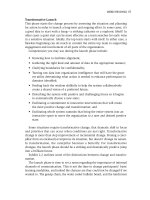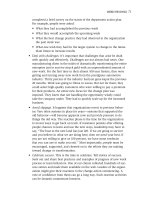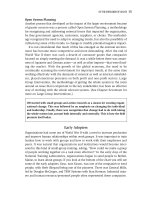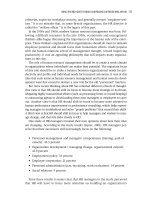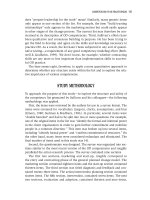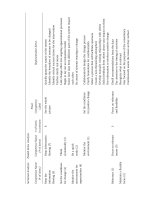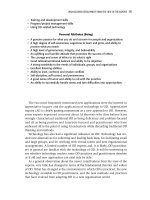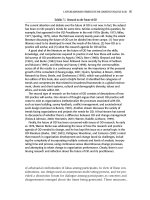Practicing Organization Development (A guide for Consultants) - Part 10 ppt
Bạn đang xem bản rút gọn của tài liệu. Xem và tải ngay bản đầy đủ của tài liệu tại đây (231.06 KB, 10 trang )
Transformative Launch
This phase starts the change process by assessing the situation and planning
for action in order to launch a long-term and ongoing effort. In some cases, it’s
a good idea to start with a bang—a striking catharsis or a euphoric liftoff! In
other cases a quiet start can be more effective as a team searches for early wins
in a sensitive situation. Ideally, the top team starts with itself. In either case, a
flawless beginning can do much to commit the entire top team to supporting
engagement and involvement of all parts of the organization.
Competencies you may use during the launch phase include:
• Knowing how to facilitate alignment;
• Gathering the right kind and amount of data in the appropriate manner;
• Clarifying boundaries for confidentiality;
• Turning raw data into organization intelligence that will have the great-
est utility determining what action is needed to enhance performance in
domains identified;
• Feeding back the wisdom skillfully to help the system collaboratively
create a shared vision of a preferred future;
• Disturbing the system with positive and challenging forces so it begins
to automatically choose a new state;
• Facilitating a commitment to innovative interventions that will create
the most positive change and transformation; and
• Facilitating whole system summits that bring the entire system into an
interactive space to move the organization to a new and desired positive
state.
Some situations require transformative change, that dramatic shift in focus
and priorities that can occur when conditions are just right. Transformative
change is more than step improvement or incremental change. Freeing a cater-
pillar from an enclosed jar improves its situation, but doesn’t change its nature.
In transformation, the caterpillar becomes a butterfly. For transformative
changes, the launch phase should be a striking and dramatically positive jump
into a brilliant future.
Exhibit 2.2 outlines some of the distinctions between change and transfor-
mation.
The launch phase is time to set a norm regarding the importance of informal
channels of communication. This is not the time to change participants’ basic
learning modalities, and indeed the chances are they could not be changed if we
wanted to. The gossip chain, the water cooler bulletin board, and the lunchroom
MODELS FOR CHANGE 61
07_962384 ch02.qxd 2/3/05 12:02 AM Page 61
62 PRACTICING ORGANIZATION DEVELOPMENT, 2ND EDITION
Exhibit 2.2. Distinctions Between Organization Change and Transformation
Change Transformation
• Single-loop learning (adapative; errors • Double-loop learning (inquires into
are corrected without altering the and changes existing norms and
fundamental nature of the system) deeper value foundations; generative
learning or learning how to learn)
• Status quo facilitated toward • Major disruption of the what is and
betterment was going to be
• Change in one or a few dimensions, • Multidimensional, multi-component
variables, or parts change and aspects
• Change in one or a few levels (maybe • Multilevel change (individuals,
the individual and/or group level) groups, or whole system)
• Change in one or two behavioral • Changes in all the behavioral aspects
aspects (attitudes, values) (attitude, norms, values, perceptions,
beliefs, world view, and behaviors)
• Quantitative change—move the chairs • Qualitative change—new ideology or
on the deck shift in philosophy
• Change in content • Change in context and underlying
structure
• Identity stays the same • Re-imagined and reformulated identity
• Corrective action • Destruction of the old way
• Continuous improvement • Discontinuous change
• Development in the same direction • Exciting, explosive, fiery, disruptive,
dramatic jumps in different directions
• Incremental changes and change that • Irreversible change with arrival of a
reverts back to the old state new state of being
• Change that does not alter the world • Change that results in a new world
view, the paradigm view, new paradigm. (The system
sees itself through a new window)
• Micro results and improvement in • Macro results and performance levels
performance never reached before
07_962384 ch02.qxd 2/3/05 12:02 AM Page 62
conversations are parts of the informal networks, often where the real conver-
sations are. It is the role of the change agent to bring the informal talk to the OD
table. Participants need help trusting a process where truth prevails and they are
ready to have a natural and authentic experience with valid data.
We expect a launch to move the organization to a point of no return. The sys-
tem moves itself to a new state in which it encompasses the essential core com-
petencies of being and becoming a change agent enterprise.
The launch (or implementation) phase we present here is distinctly different
from our change model in the previous edition. In the 21st Century, change hap-
pens so fast that it seems it is at the speed of imagination. There is seldom time
for a long assessment with a change plan.
Today, we see the change cycle requiring a process and philosophy built in
for constant reaction and continual planning efforts. It is not a phase of a long-
term effort, but rather an ongoing implementation of a myriad of interventions,
an endless loop of short-cycle change.
In fact, these days, the traditional assessment and action planning can all
happen in three or four days’ time if all key stakeholders are in the room. The
resistance that took years to unfreeze in the traditional action research model
can now be broken in an afternoon if all the right people and information are
present.
In Figure 2.4, you can see the launch phase broken out into a sub-model,
which we call SPAR: Scan, Plan, Act, and Re-Act. This simple model is univer-
sal in application. This kind of change model is not just useful for one’s work-
life but may be used in one’s personal and recreational life as well. Client
system, family, or little league team—the principles are the same. It can be used
in a long-term effort or in an intervention as short as a ten-minute phone call. It
can be used as an intervention at any level of change. For example:
• An individual can use it to make changes in his or her own life;
• A coach or mentor can use it to work with a client;
• Two members of an executive team can use it to find new ways to
collaborate;
• A team can use it to learn how to be more effective;
• Multiple teams can use it in the application of system theory and practice;
• Institution or enterprise-wide change efforts can use it—especially in
ongoing, engaging change; and/or
• Network, community, or trans-organization development efforts can
employ it.
MODELS FOR CHANGE 63
07_962384 ch02.qxd 2/3/05 12:02 AM Page 63
Each phase or each session within a phase may include all four elements of
SPAR. That is the Chinese box phenomenon—the famous puzzle consisting of a
series of progressively smaller boxes inside a large box—which may typify many
change efforts. In other words, when a change effort is big enough and long-term
enough, the assessment and feedback moment or experience (for instance) may
itself have an entry component, a start-up component, and so forth.
Scan. Diagnosis traditionally is the phrase that has been used to describe the
major function of the scan phase. Our quantitative research over the years
involving almost four thousand change agents has produced many heated
arguments over whether to use assessment or diagnosis. We have been won
over to the assessment side of the street because diagnosis comes more from a
disease and medical model looking for something that is sick or problem-related.
We prefer to look on the bright side of life. The glass is half full. Like the appre-
ciative inquiry change agents, we strongly believe in the new positive psychol-
ogy movement. Assessment is typically known as a classification of someone
or something with respect to its worth. When a change process is positive, con-
versations are energizing. The process entropies when conversations are about
problems, negativity, and the blues.
This is the phase where valid information is central. Common sense and clas-
sic research agree. Too often we see people in organizations jump right into the
end-state planning without generating an accurate picture of where they are
now and a clear view of a desired destiny.
It’s important for the client to feel ownership of the assessment information. The
more we can involve the client in jointly bringing forth valid information the bet-
ter. A key competency to be utilized here is the ability to create a trusting climate
so the client feels safe to reveal disturbing, grandiose, or thought-provoking
information and feelings. Gathering stories of best practices from within or
from without the system is often exhilarating. A positive spirit of inquiry melts
resistance.
Active and non-judgmental listening is paramount at this phase. When the
client senses that the consultant is being judgmental, the consultant’s ability to
facilitate is impaired, and his or her influence is lessened. Trust is reduced
because the common ground that is facilitated toward is colored with the con-
sultant’s own bias. Of course, there are exceptions. Sometimes a consultant will
have one gigantic idea, and all will say, “YES! YES!” and welcome the contri-
bution because the people in the system as a whole will benefit. Living systems
move in the direction of what is assessed as being worthy.
Asking the right questions is key. David Cooperrider (founder of appreciative
inquiry, which depends heavily on crafting the right questions) says that he
spent days of intense concentration determining the exact questions he would
64 PRACTICING ORGANIZATION DEVELOPMENT, 2ND EDITION
07_962384 ch02.qxd 2/3/05 12:02 AM Page 64
use in breakout groups while he facilitated leaders of all the major world reli-
gions in a summit. Asking the right questions has much to do with where the
client system lands in the next phase of planning.
Questions might include:
• What’s up?
• What is working?
• What is our purpose?
• What outcomes do we wish to reach?
• What are your wishes and dreams?
• What do we want to change?
• What is a focus that you could really become passionate about?
• What best practices do we wish to enhance?
• What changes can we make to augment communication?
• Describe an ideal organization structure.
• Give me one strategy that if implemented would make a huge difference.
Usually we like to co-create scanning questions with the client. They know
better than we do what is important. Often they need help rephrasing questions
that could elicit negative, and perhaps unhelpful, responses. For example, “What
is the problem with quality?” could become “What can you do to ensure supe-
rior quality?” or “The best example of high quality I have experienced around
here is. . . .”
In sum, the scan phase is about helping the client system get a comprehen-
sive view from individuals or small groups about where they are and wish to
be. Creating a system-wide synthesis and common-ground intelligence base
comes in the next phase.
Plan. There is a wide assortment of techniques and methods that can be used
to plan what you will act on. What approach should you use? It all depends. It
may depend on the scope of the effort, the style of leadership, or the nature of
the data-collection methodology. One idea is to have a change team represen-
tative of the larger system help design a planning process that fits the situation.
Here are some practical tips for the plan phase:
• Feed back the data in a distilled manner. Normally, one has more data
than can be used. A process needs to be invented that will funnel all the
accumulated ideas into common themes. Go for ideas that can easily
MODELS FOR CHANGE 65
07_962384 ch02.qxd 2/3/05 12:02 AM Page 65
turn into new attitude and behavioral commitments and action items.
Involve participants in organizing the ideas. We do not encourage pre-
pared recommendation reports assembled in the closet of the consul-
tant’s office and then presented and sold to the clients. Always prepare
the data for planning with clients.
We recall working with a large financial system. The top team had just
spent hundreds of thousands of dollars with a large European consulting
firm that recommended a strategic plan to them. The CEO and execu-
tives just did not “own” it. We helped them rip up the plan and within
four hours they had a new strategic plan. Subtle but significant adjust-
ments were made. Now the team was excited about it. They owned it.
As the old adage, generally attributed to Peter Drucker, goes, “People
support what they help create.”
• Spend some time validating the data that was collected. Clients need help
seeing collectively the state they are in. Rarely will they deny what has
surfaced. Validating accommodates ownership and ultimate commitment.
• Do allow the system to disturb itself. Do facilitate so clients are able to
confront themselves. Do allow them to self-realize what they will do
with the dissatisfaction. Facilitate a wake-up call. Get their attention.
The value of a consultant is to help the system face itself as it is and to
realize what it wishes to become.
In a keynote address to a national conference, Fritz Capra (2002), said,
“People rarely do what top management wants them to do. When the
system modifies the direction, they respond creatively to a disturbance.
Rather than ignore it, we can work with people’s creativity and trans-
form it into a positive force. If we involve people in the change process
right from the start up, they will ‘choose to be disturbed’ because the
process itself is meaningful to them.”
We think Dr. Capra’s statement is powerful. When people in the system
are having a truthful dialogue, someone is being disturbed. Yet the emo-
tional juice coming from a deep and substantial dialogue cements com-
mitment to implementation in the act phase.
• Be sensitive in confrontation. Clients want to get rid of a past that is not
working, but need help to destroy a past that is nonetheless theirs.
Know how much disturbance they can handle. Realize that more change
will happen if feelings are evoked and worked through. Authentic feel-
ings in a room set the stage for serious and concentrated conversations.
So it’s important to only intervene as deeply as you know the client can
handle. Expert and masterful facilitation is required, especially if there
are five hundred people in the room.
66 PRACTICING ORGANIZATION DEVELOPMENT, 2ND EDITION
07_962384 ch02.qxd 2/3/05 12:02 AM Page 66
• Together create compelling propositions. Establish a realistic preferred
future that grows out of all the work that has been done up to this point.
Unleash the creativity. Blend in the weird. Go for the moon. Develop a
bold plan that matches the audacious and enterprising times of today.
Challenge clients to make a dramatic difference, a difference that will
have a huge impact on the success of the system. Help them create a
future that will give them a real reason to believe in themselves. They
have it in them. The answers are in the system. Surface them. Bring
them to life. Just pull the right cords to unleash the extraordinary mind
power that all systems have. Let the compelling possibility give them
hope.
• Ensure that clients are able to freely choose their plan. This concept is
paramount. Remember the financial case above where the executive
team did not buy the strategic plan until they felt they freely chose it.
People follow through and own the plan when they have choices.
• Anticipate and name the resistance that may arise. You considered all
possible sources of resistance in your planning and engaged people in
the project insofar as possible. Still, additional resistance may arise now
that implementation is inevitable. Rehearse how the different choices
may play out, and consider ways to involve people even at this point,
giving them options in implementation that will help them feel a mea-
sure of control over their destinies.
• Create a simple, elegant master plan format. The plan should go after spe-
cific actions that can make the biggest splash with the least amount of
resources and effort. Surface the priority focus. Establish long-term goals,
but only specify activity for shorter periods, certainly not more than 120
days. Most organizations are moving too fast to plan in detail much fur-
ther out. Ideally you will be able to publish the plan on a website. One of
our clients used a technology where an automatic email was sent to the
person responsible to alert him or her before an action was due.
Here’s an example of the potential power of such a process. We had a three-
day whole system transformation summit with the top 350 people of a Fortune
250 organization. During one module of the design, the issue for interaction was
the executive team’s relationship with the remaining 340 leaders. A design team
created an activity so the room could react to the behavioral commitments that
the executive team made in the previous year’s summit. After a very honest and
open reaction from the first table’s report-out, the second person reporting
started by acknowledging his pleasure with the directness that had been heard
and said, “I think we must hear a detailed assessment of the executive team
MODELS FOR CHANGE 67
07_962384 ch02.qxd 2/3/05 12:02 AM Page 67
from every table in the room.” Applause and a standing ovation occurred. On
the spot we changed the design so all were heard. The rapt attention of the par-
ticipants was stunning. The executive team spent from 8:00 p.m. to 1:00 a.m.
crafting their response. When they presented it the next morning, they received
a standing ovation. The people had been heard! In fact, this group decided not
to have any structured follow-up or reaction phase. They did not need it. They
just went and performed. Six months later when the board was challenging the
executive team about flying three hundred people to Minneapolis for the ses-
sion, the second person in charge said, “Remember how you have been chal-
lenging us for the last five years to increase our profit in one of the financial
variables. Well, look at the numbers. Note the five-million-dollar difference. We
know that was the result of our organization change summit.”
Act. Acting the plan is the heart and soul of what we do in OD, where the inter-
ventions we have planned with clients are carried out. The Act phase is where
we get the results, where we add value. When we do it well, performance
increases. If we have done all previous phases and sub-phases competently, suc-
cess should spontaneously and authentically occur.
Chris Argyris offers a clear, simple, and profound statement around “Act.”
He writes, “In order to act, human beings diagnose problems, invent solutions,
and evaluate the effectiveness of what they have produced” (2004, p. 2). These
are indeed the same steps we are describing in SPAR. A key competency of an
OD practitioner is to facilitate client conversation to help these effective change
actions happen.
Argyris continues by saying, “Productive reasoning (1) produces valid and
validatable knowledge, (2) creates informed choices, and (3) makes personal
reasoning transparent in order for the claims to be tested robustly. The core of
productive reasoning is that the parties involved are vigilant about striving to
avoid unknowingly deceiving themselves and others” (2004, p. 3).
The following are some practical tips for the Act phase:
• Increase the quality of the conversation. Being transparent includes fish-
ing for doubts and reservations so the concerns of all parties can be on
the table. Name the resistance and honor it. It is amazing how resisters
move if they are allowed to have their voices heard. Alternative and dis-
senting views often enrich the solutions. Part of our role is to surface the
“undiscussables,” to surface the below-the-table thinking, to shed light
on the shadow of the system. To get a view of the “whole,” representing
all parts of the system is required. (Of course, we must do so without
getting ourselves fired by leadership that is not yet prepared for truth.
And we must protect the truth tellers so they will continue to feel safe in
speaking their view of the truth.)
68 PRACTICING ORGANIZATION DEVELOPMENT, 2ND EDITION
07_962384 ch02.qxd 2/3/05 12:02 AM Page 68
Peter Block (2000) believes that this openness cannot be limited to
when the consultant is present or happen only in offsite team building
or whole system transformation summits. It must occur each time the
people assemble in their daily work routine.
What happens in the whole system transformation summits, as we have
named our large group work, is that the quality of the interaction, often
for the first time, changes for the better. The challenge is to transfer
what happens in change efforts into the daily operations of the system.
• Facilitate high-performing relationships. Let us share an example. We had
an executive team come to a four-day residential retreat prepared to light
the fire in their team. The first day they were overwhelmed by the chal-
lenges before them. The team went into a funk. We anticipated such a
state from our scan. We knew that there were serious relationship issues
in the team so we spent a couple of days in deep dialogue around spe-
cific relationships and the climate of the team as whole. By noon of the
third day, there was a dramatic shift. They begin to feel a confidence that
they could handle the challenges before them better than any other team
in the world. Why? We believe that the time they spent in effective dia-
logue (and our masterful facilitation, of course) moved them to a place
where they deepened the genuine connection to all others in the team.
Deep relationships generate confidence to act on significant challenges.
• Establish a climate of trust and openness. Our experience indicates that
participants become very excited and engaged while they are working
with the reality of their system. Without doubt, if they have been in
honest dialogue, they will be likely to generate effective solutions.
Expectations increase. An increase in results often does not happen until
an expectation is declared.
• Empower all to “act” through engagement. Peter Block acknowledges
that he learned much about engagement from Kathie Dannemiller.
Kathie is known for her co-invention of whole-scale-change methodolo-
gies and especially for her belief in empowerment. Peter says:
“A core strategy for building emotional commitment to implemen-
tation is to design new ways for people to engage each other. This
may be more critical than the clarity or rightness of a decision.
Results are achieved when members of a system collectively choose
to move in a certain direction. It is this act of choice that is
critical. . . . We tenaciously hold onto the belief that leaders can
induce others to act. Leaders can no more induce action on the
part of their followers than consultants can induce action on
the part of their clients.” (2000, p. 265)
MODELS FOR CHANGE 69
07_962384 ch02.qxd 2/3/05 12:02 AM Page 69
• Ensure that the people in the organization are prepared to support the
action. We have found that it is best if the entire system is engaged in
helping leadership define high performance behavior. If it happens, the
payoff is remarkable. If the participants have been genuinely connected to
the change process up to this point, support, ownership, and commitment
will prevail. Also structures, high-level systems, policies, and procedures
must be adapted to help the system conduct the “Act” phase successfully.
• Engage the leaders. Leaders must visibly support the action. If in the
past they were among those leaders who do not walk their talk, a
change process is a great opportunity for them to now have a break-
through. Anyone can change behavior. The desired behaviors just need
to be clarified and committed to. Leaders need to model the changed or
transformed mindset. How the organization views the congruency of
leadership cannot be underestimated.
• Help internal change agents. They can prepare to and be available to
move the action plan forward. If the SPAR model is effective, the client
group’s resolute spirit reaches out to internals to receive support and
assistance in realizing their dreams. Perhaps they can be of assistance in
areas that may be “stuck.” In other instances, internal practitioners can
offer themselves as coaches. Essentially, this is the time for them to initi-
ate their own “SPAR” process. They will best serve the system if they are
continually scanning, planning, acting, and re-acting to what is occurring.
Re-Act. The “Re-Act” phase occurs in more than one way. Planning renewal is
a must. Re-action is necessary as the organization responds to the implemen-
tation of the plan. The action plan always evolves differently than you might
have expected, so your plan must be updated and adjusted. Reaction feeds cor-
rective action. Now is also the time to extract the learning from the previous
three phases, and to be prepared for the next cycle of SPAR.
The following section highlights some issues related to this phase:
• Obtain information on which to base re-action. One of the best ways to
get reaction is to have informal and frequent sessions where participants
can converse. That will allow unforeseen obstacles and developing resis-
tance to be identified. This is the time to monitor what has taken place.
Monitoring may include scientific or non-scientific measured
reactions to what has happened and is taking place. Monitoring is the
reflective process to discern what we have learned from what has just
happened in the previous three steps to guide us as we repeat SPAR.
It may be done with periodic online surveys. One company had all
computers set so they would not fire up until the person signing on
70 PRACTICING ORGANIZATION DEVELOPMENT, 2ND EDITION
07_962384 ch02.qxd 2/3/05 12:02 AM Page 70

